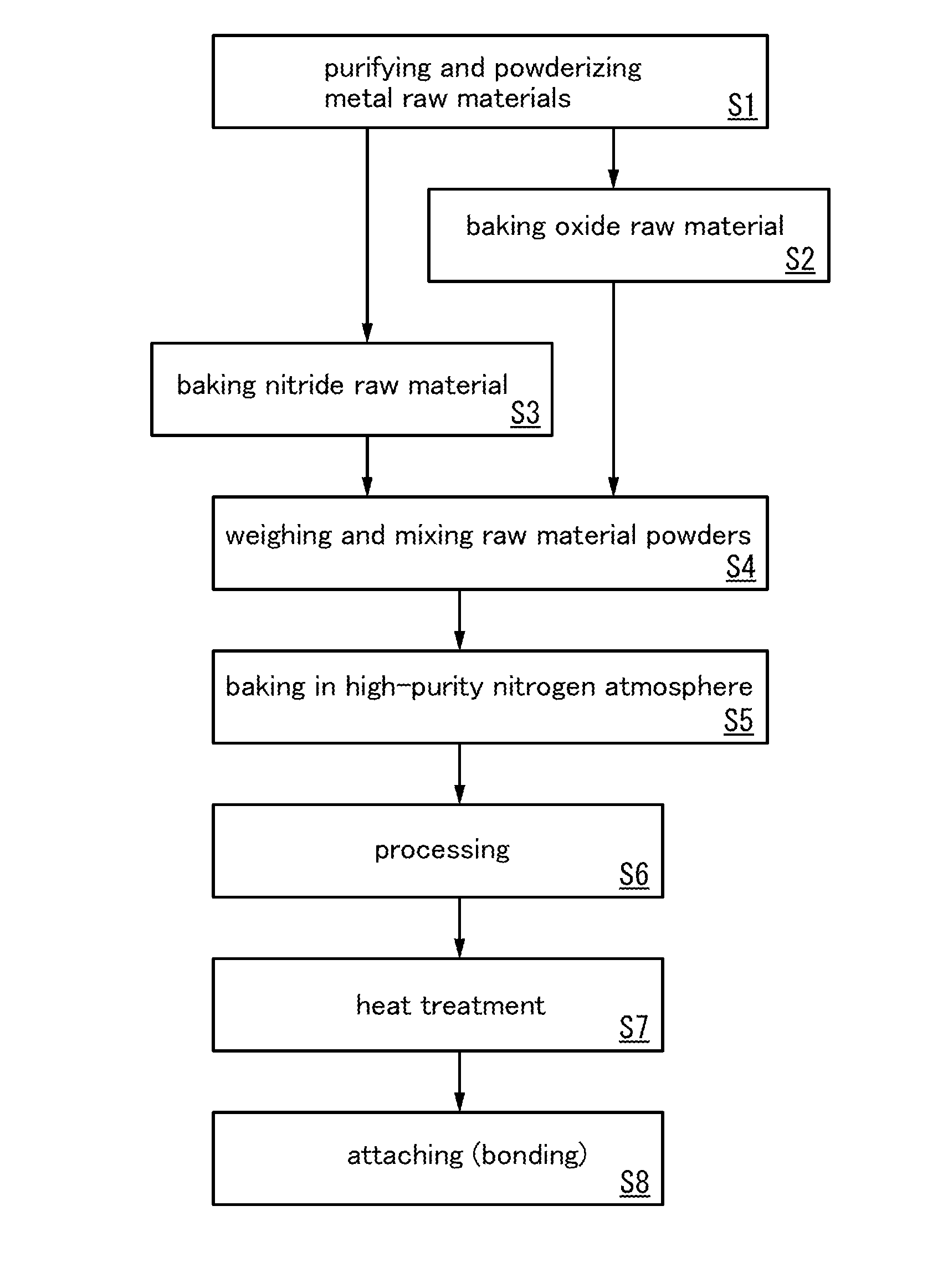Sputtering target, method for manufacturing the same, manufacturing semiconductor device
a technology of sputtering target and semiconductor device, which is applied in the direction of diaphragms, preheating charges, metallic material coating processes, etc., can solve the problems of preventing the formation of a compound having a desired nitrogen concentration in some cases, and the concentration of nitrogen is not high enough,
- Summary
- Abstract
- Description
- Claims
- Application Information
AI Technical Summary
Benefits of technology
Problems solved by technology
Method used
Image
Examples
embodiment 1
[0061]In this embodiment, a method for manufacturing a sputtering target which is one embodiment of the present invention will be described with reference to FIG. 1. FIG. 1 is a flow chart illustrating an example of a method for manufacturing a sputtering target according to this embodiment. Although manufacture of a sputtering target of an In—Ga—Zn—O—N-based compound is described below, manufacture of a sputtering target of another oxynitride can be performed similarly.
[0062]Here, a case is described where a sputtering target is formed by baking indium nitride, gallium nitride, indium oxide, gallium oxide, and zinc oxide as raw materials. First, zinc, indium, and gallium are each purified by repeating distillation, sublimation, or recrystallization. The purity of each of the materials is made 99.99% or more, preferably 99.9999% or more. After that, the purified metals are each processed into a powder form (S1).
[0063]Metal zinc, metal indium, and metal gallium which are highly purif...
embodiment 2
[0083]In this embodiment, one embodiment of a semiconductor device and a method for manufacturing the semiconductor device will be described with reference to FIGS. 3A to 3C, FIGS. 4A and 4B, and FIGS. 5A to 5E.
[0084]FIGS. 3A to 3C are a top view and cross-sectional views illustrating a transistor 151 which is a top-gate top-contact type as an example of a semiconductor device according to one embodiment of the present invention. Here, FIG. 3A is a top view, FIG. 3B is a cross-sectional view along A-B of FIG. 3A, and FIG. 3C is a cross-sectional view along C-D of FIG. 3A. Note that in FIG. 3A, some of components of the transistor 151 (for example, a gate insulating layer 112) are omitted for brevity.
[0085]The transistor 151 in FIGS. 3A to 3C includes an insulating layer 102, an oxide semiconductor layer 106, a source electrode 108a, a drain electrode 108b, the gate insulating layer 112, a first gate electrode layer 114, and a second gate electrode layer 115 over a substrate 100.
[008...
embodiment 3
[0163]In this embodiment, an example of a manufacturing process of the transistor 152 in FIG. 4A will be described below with reference to FIGS. 6A to 6E.
[0164]First, the insulating layer 102 is formed over the substrate 100 (see FIG. 6A). Next, a conductive layer for forming of the source electrode and the drain electrode (including a wiring formed in the same layer as the source electrode and the drain electrode) is formed over the insulating layer 102 and processed to form the source electrode 108a and the drain electrode 108b (see FIG. 6B).
[0165]Next, an oxide semiconductor layer connected to the source electrode 108a and the drain electrode 108b is formed over the insulating layer 102 and then is processed to form the oxide semiconductor layer 106 having an island shape (see FIG. 6C). After that, first heat treatment similar to that performed on the transistor 151 may be performed.
[0166]Next, the gate insulating layer 112 is formed so as to cover the source electrode 108a and t...
PUM
| Property | Measurement | Unit |
|---|---|---|
| length | aaaaa | aaaaa |
| gate potential | aaaaa | aaaaa |
| length | aaaaa | aaaaa |
Abstract
Description
Claims
Application Information
 Login to View More
Login to View More - R&D
- Intellectual Property
- Life Sciences
- Materials
- Tech Scout
- Unparalleled Data Quality
- Higher Quality Content
- 60% Fewer Hallucinations
Browse by: Latest US Patents, China's latest patents, Technical Efficacy Thesaurus, Application Domain, Technology Topic, Popular Technical Reports.
© 2025 PatSnap. All rights reserved.Legal|Privacy policy|Modern Slavery Act Transparency Statement|Sitemap|About US| Contact US: help@patsnap.com



